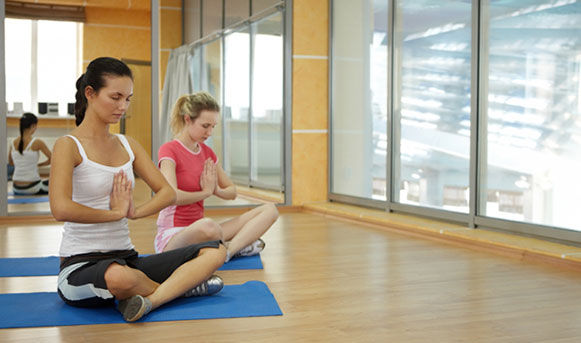
The yoga classes seen in most gyms are a form of hatha yoga, which is a practice that focuses on using physical postures to strengthen and lengthen muscles. However, there is much more to this ancient practice than just exercise, and there are many additional ways yoga can be of benefit to your fitness clients.
Yoga poses (known as asana) are only one part of this mind-body method. “Non-physical” yoga techniques include meditation, breathwork and seva (selfless service).
If you are a personal trainer or group exercise instructor, selectively adding non-physical yoga practices to client sessions can boost workout variety and interest. Read on to deepen your understanding of “non-hatha” yoga techniques that can help your participants attain better results in their fitness, weight-loss and life-balance goals.
The Other Parts of Yoga
Although there is no single, official way to practice yoga, many practitioners believe strongly in the philosophies outlined in the Yoga Sutra, an ancient text believed to be two thousand years old. The writings describe how to live life according to yogic philosophies by following an “eight-limbed path.”
The exercise part of yoga (asana; the postures now prevalent in many gym classes) is one of the eight paths. Yet several others—such as dhyana (meditation) and pranayama (mindful breathing)—can easily be included in non-yoga fitness sessions. (For more on the eight limbs, click here.)
Adding Yogic Techniques to Your Classes and Training Sessions
Why should this matter to fitness professionals? There are many times when your students may need more than just exercise, says Suzette O’Byrne, a faculty member with Mount Royal University’s Yoga Therapy Program in Calgary, Alberta.
“When your client is in pain, stressed, emotional or just living in a non-functional body, other non-physical yoga tools can be incredibly helpful,” O’Byrne continues. “As a yoga therapist and ACE Certified Personal Trainer, I am frequently asked to consult and work with other trainers’ clients on breathwork and or relaxation training.”
Here are five yogic techniques that you can use to add small doses of mind-body support to your personal training and group exercise sessions.
Sample Script for Guided Relaxation
Use guided relaxation at the end of an exercise session to guide your clients through a peaceful experience. “Keep the focus on the body and the mind will automatically become calm,” says yoga pro Lauren Eirk. The following is a modified version of a script she uses:
“Breathe deeply for a few breaths…notice the rib cage moving in and out and give yourself some you time.
On the next inhale, squeeze all the muscles in both of your legs….Be nothing but your legs and engage muscles around the knee, hip, and ankle joints. Take another breath…and now relax the legs completely.
Inhale again. Now moving to the upper body, squeeze your arms and hands as hard as you can. Be nothing but your upper body. Squeeze...and let them melt into the floor.
Relax your shoulders away from your ears and smooth out the skin across your face. Continue to inhale deeply….Exhale…in…out…for a while.
When you are ready…slowly open your eyes and readjust to your surroundings. Take this feeling with your the rest of your day and be thankful for the great things your body did for you today!
1. Body Scanning and Mind-body Awareness
A yoga class in a dedicated studio typically begins with a brief moment of self-observation and conscious breathing.
The instructor may cue several slow, deep abdominal breaths, and ask students to consciously scan their bodies for any points of tension. Participants are encouraged to become aware of their level of physical and mental fitness or fatigue at that moment. This ritual empowers trainees to exercise according to their individual needs that day.
In the Gym: Body scanning can be used at the beginning or the end of group fitness classes or personal-training sessions, adds O’Byrne.
If at the beginning, “have your clients silently ask themselves: How am I feeling today? What does my body need today? Most importantly: What is my intention for this workout and this day?” adds Lauren Eirk, M.S., who is the creator of the biomechanically based teacher training school Yoga I.S. (Yoga Integrated Science) in Louisville, Ky.
2. Selfless Service (in Sanskrit: seva)
In yoga, seva refers to “selfless service,” or helping others with a sense of compassion and without regard to personal gain. In practical terms, this may take the form of community volunteer work, or simply helping a neighbor out with a practical project.
“One of the best ways to lose weight and gain a better understanding of who we are mentally and physically is by turning the focus away from ourselves,” says Beth Shaw, the Los Angeles, Calif.based founder of YogaFit, an educational partner with ACE that has provided fitness facility-friendly yoga training to more than 200,000 instructors worldwide.
In the Gym: Encourage participants and trainees to engage in volunteer work as a means of managing stress or to help overcome a difficult situation. “I remind students that the best way to feel better about themselves is to do something kind for someone else,” notes Eirk.
Of course, stay within your scope of practice and refer your client to a qualified mental health professional or physician if he or she demonstrates red-flag concerns beyond day-to-day stresses.
3. Focal Words (mantra)
In yoga, silently or verbally repeating a word or syllable during a meditation or movement practice is called japa; the word or sound is known as a mantra. Mantras can aid concentration and boost performance during a meditation or an exercise sequence, such as a yoga flow (a series of linked yoga postures), a set of repetitions during a strength training set, or cardio exercise like running.
“Focusing attention on the present moment is a huge teaching in yoga,” says Eirk.
In the Gym: Have your client think of a word such as “focus,” “relax” or “strength.” To improve concentration, he or she should focus on nothing but that word over and over and breathe deeply, either during a post-workout relaxation session or during active exercise like weight lifting.
Ujjayi Breathing
To perform ujjayi breathing, exhale from deep in the abdominal region by gently tightening the core. At the same time, lightly constrict the throat muscles says Lauren Eirk.
Cues like “exhale as if you were trying to fog up a mirror” can help clients understand the exhalation, which can be softly audible and sound like a hissing in the back of the throat.
A weight belt may produce similar results as the abdominal muscle engagement present in ujjayi breathing. However, ujjayi teaches the client how to maintain a specific trunk position using the necessary muscular recruitment needed to move heavier loads, as when lifting weights, Eirk notes.
4. Breathwork (pranayama)
Breathing exercises—known as pranayama—are an integral part of yoga.
The benefits run deep. “While yoga practitioners have used breathing practices for thousands of years, scientists in the Western world have only recently recognized that deep, controlled breathing has a direct correlation with improved health,” says Shaw, who is also the author of YogaLean: Poses and Recipes to Promote Weight Loss and Vitality-for Life! (Ballantine Books, 2014).
In the Gym: Encourage clients to take several full, measured breaths before beginning a workout (this same technique is typically used in yoga classes). This can be done as a conscious meditation prior to the workout, or during the dynamic warm-up if pressed for time.
“This is a great awareness tool for beginners for realizing the potential depth of their breath and the capacity of their lungs,” says Shaw. (She describes an easy-to-teach deep-breathing method called “YogaFit’s three-part breath” on page two of this article.)
Another option? “During higher resistance routines, the trainer can employ ujjayi pranayama, a technique that requires the engagement of the transverse abdominis region to create intra-abdominal pressure, and strong exhalation, says Eirk. (See the sidebar to learn how.)
Outside of the gym, encourage clients to check in with their breath throughout the day and to notice how their breath is moving. They should ask themselves if the way they are breathing (shallow, deep, fast or slow) is appropriate for what they are doing, and when and where they can relax more throughout their days.

5. Meditation (dyanha)
“Meditation doesn’t teach you to avoid pain or discomfort, but to experience and accept it so you can move through any situation with profound clarity and calm,” explains Shaw.
We often rush clients through a super-quick cool-down and stretch session. Yet for many, a three- or five-minute closing meditation, performed seated or lying down, may be the only oasis of calm they experience all day.
In the Gym: Fitness professionals can easily borrow the concept savasana or “corpse pose” in yoga, in which participants lie down and fully relax for about five minutes at the end of a workout, breathing deeply and focusing on the present moment.
Rather than aiming for an “empty” mind during savasana-time meditation, Shaw encourages her students to concentrate on n appropriate mental focal point. Focal points could include a mantra, one’s own breath (counting “one, two, three” on the inhale and “three, two, one” on the exhale) or a guided relaxation script (see sidebar for an example).
Putting it all Together
“Yoga addresses more than the physical body and has tools for addressing the whole person,” O’Byrne says. She notes that this whole-person approach is not unlike other techniques used in Western medicine, such as relaxation therapy or life coaching.
“Trainers need to honor what the client needs, and take the time to encourage the client to be unattached to outcome, and to be content with where he or she is today,” says Eirk. “Emotional needs are as important as physical, and we fitness professionals need to stop putting them into separate categories.”
Take a step toward meeting those needs by applying techniques from the non-physical aspects of yoga and help your clients along the path toward more complete and long-lasting health.





 by
by 



